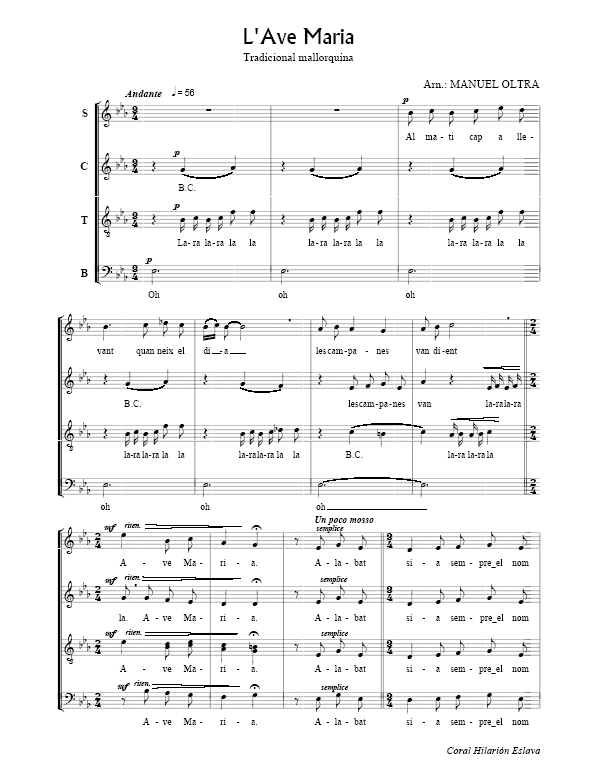L'Ave Maria
Composer: Manuel Oltra i Ferrer (*1922), 1963

| Recording:
not available |
| Lyrics: not
available |
|
see score |
|
| Score: free
download on THIS PAGE |
 |

| Posted on YouTube: Not available at
this time. |
|
You could be
featured here!
If you (or your choir) perform this Ave Maria, make a video recording.
Post your video on YouTube, email me the page URL and I'll embed the video
in this page. |

You can also email me an MP3 for audio only. |

| Internet
references, biography information. |
|
source |
|
Manuel Oltra i Ferrer
Neix a València el 8 de febrer de 1922 i resideix des del mateix any a
Barcelona. Comença els estudis musicals als 14 anys amb el mestre Josep Font
Sabaté, i ho fa intensivament a desgrat dels entrebancs propis de la guerra
civil, del trasllat de la seva família a Lleida l'any 1940 i de la
incorporació a l'exèrcit el 1943.
Aquesta darrera circumstància que l'obliga a traslladar-se a Ceuta,
representa un trasbals per a la seva carrera; sortosament es resolgué aviat
en aconseguir una plaça de professor al Conservatori Hispano-Marroquí de
Tetuan. Tres anys després, acabada la milícia, torna a Barcelona on comença
la seva activitat plenament musical com a pianista, director i compositor.
Ha exercit la docència també en l'Institut de Rítmica Joan Llongueres, i com
a responsable de cursets i classes magistrals en diverses entitats; ha estat
director musical de moltes agrupacions folklòriques, com la Coral C.E. de
Terrassa, els Esbarts Montserrat i Montseny, Ballets de Catalunya, Esbart de
l'Orfeó Gracienc, etc.
La seva producció com a compositor és extensa i variada, abarcant gairebé
tots els gèneres: obres de cambra per a diversos conjunts, obres simfòniques,
obres corals "a cappella" o amb acompanyament instrumental, i obres per a
cobla, de les quals es podria destacar, potser, la "Rapsòdia per a piano i
cobla" (1953) en la que, per primera vegada, es produeix una semblant
conjunció. Les harmonitzacions de cançons i ballets tradicionals formen
també un corpus notable.
L'any 1994 va rebre de la Generalitat de Catalunya el Premi Nacional de
Música en l'apartat de composició i el Premi Nacional de Cultura Popular i
Tradicional en l'apartat de Música.
|
|
source |
Manuel Oltra (1922), composer
--------------------------------------------------------------------------------
His career is closely linked with the Barcelona Municipal Conservatory of
Music where he studied, taught and was a governor. I have already spoken of
Oltra as a composer par excellence. Musicians who have had contact with him
and his methods of working agree, with rare unanimity, that he is a great
musician and a great teacher. A man with a deep knowledge of composition,
transcription and instrumentation techniques, in short a scholar of music.
Throughout his career Oltra followed his own path without becoming part of
any particular group or tendency. He refused to be discouraged when accused
of not being innovative and concentrated on making music of quality. Oltra
would tell how he had learned instrumentation by sitting at home with
orchestral scores and trying to imagine how they would sound. Then, with the
score in his hand, he would go to the second floor of the Palau de la Musica
to see if they really sounded as he had imagined or how they differed.
Among Oltra¹s works are Suite for strings and flute (1953), Rapsòdia for
piano and cobla (3), El bestiari de Pere Quart for choirs (from 1957),
Cantata per a cor infantil, cobla i percussió, Sonata for cello and piano,
(1959), Doble 5. Suite per a quintet de corda i quintet de vent (1962,
Psalmus brevis (1967), for choir and orchestra, Simfonia esparsa (1989) and
many songs and melodies for popular songs. Sonatina per a flauta i piano
(1950) is the work of a young man, written when he was twenty-eight it
remains one of his personal favourites. Oltra claims it is one of the few
works that he wrote spontaneously, from beginning to end, simply, without
doubt, following his instincts. The language of Sonatina is clearly tonal,
structured like a sonata with a simple, transparent design.
Tres estacions was composed in 1989 and so is a mature work. It is
structured in three parts, starting with a sonata: autumn (fast), winter
(lyrical) and spring (rondo). Although Oltra¹s music tends to be carefully
constructed, in Tres estacions there are more descriptive passages. This
produces a powerful cerebral work with a perfect balance of composition. The
notes are transparent and precise, nothing is superfluous. Oltra¹s deep
knowledge of the composer¹s craft gives his music an aura of perfection.
According to those who have interpreted his work, the intrinsic interest of
the music makes it easy to play and requires little effort. In contrast to
the Sonatina the language of this work is more advanced and the tonality is
far more ambiguous without being abandoned completely.
There is always something in Oltra¹s work, sometimes hard to define exactly,
that marks it as part of Catalan musical tradition. This, in one way or
another, also applies to Manén and, above all, to Toldrà. Apart from the
Sonatina all the works on this disc are first recordings.
|



Please notify us of any broken/defective links

Page last modified:
September 16, 2011
Return to my homepage:
www.avemariasongs.org

|
![]()